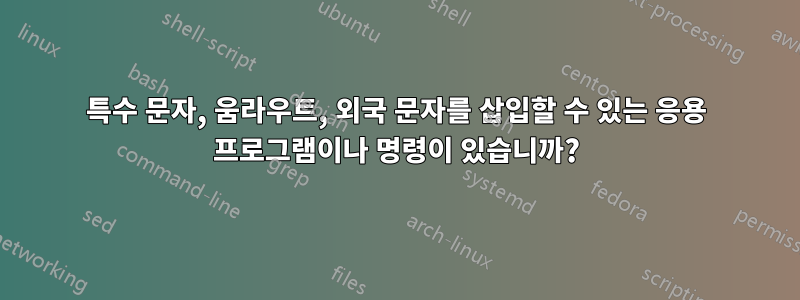
저는 독일어, 스페인어, 프랑스어, 그리스어, 영어 등 여러 언어로 글을 쓰고 작업합니다. Mac에서는 2초 이상 키를 누르면 주인공에서 파생된 특수 문자 중에서 선택할 수 있습니다. Windows에는 동일한 기능을 수행하는 Holdkey라는 소프트웨어가 있습니다. Linux에도 비슷한 것이 있나요? 아직 찾지 못했습니다.
답변1
저는 두 가지 조언을 드립니다:
- 적합한 키보드 레이아웃, 즉 데드 키가 있는 레이아웃을 사용하십시오. 영어 키보드가 있는 경우 예를 들어 선택하세요.영어(미국, 국제, 데드 키 포함). 그러나 몇 가지 다른 변형이 있습니다.
- 정의하다작성 키. 이렇게 하면 사용 중인 키보드 레이아웃에 포함되지 않은 많은 문자를 입력할 수 있습니다. (Compose 키는 XKB 기능이므로 Kubuntu에서 사용할 수 있지만 거기서 정의하는 방법을 알아내야 합니다.)
답변2
설정하는 것이 두렵지 않다면(지침이 명확해야 함) 아래에서 자주 사용하는 특수 문자(-대체 문자)를 빠르게 삽입할 수 있는 대안을 제공할 수 있습니다.
편집 가능한 특수 문자 도구
아래 스크립트는 자주 사용하는 문자를 즉시 사용할 수 있도록 하는 유연한 도구(클릭으로 문자를 삽입하는 창)입니다.
작동 원리
- 바로가기로 창호를 호출하세요
- 문자를 삽입하려면 해당 문자를 클릭하기만 하면 작업 중이던 창에 문자가 붙여넣어집니다.
문자 세트를 추가하려면 다음을 누르십시오. + 텍스트 편집기 창이 열리고 첫 번째 줄에 "가족" 이름을 추가하고 다음 줄에 관련 특수 문자를 한 줄에 하나씩 추가합니다. 예:
a å ä ã â á à ª(이미지에서). 파일을 닫으면 다음에 창을 호출할 때부터 특수 문자를 사용할 수 있습니다.
- 사용 가능한 문자 세트를 삭제하려면 다음을 누르십시오.x
설정 방법
몇 가지 종속성을 충족해야 합니다.
python3-xlib
sudo apt install python3-xlibpyautogui:
pip3 install pyautogui파이퍼클립:
sudo apt install python3-pyperclip xsel xclipWnck를 설치해야 할 수도 있습니다.
python3-gi gir1.2-wnck-3.0
로그아웃했다가 다시 로그인하세요.
아래 스크립트를 빈 파일에 복사하고 다른 이름으로 저장하세요
specialchars.py.실행 가능하게 만들어라#!/usr/bin/env python3 import os import gi gi.require_version("Gtk", "3.0") gi.require_version('Wnck', '3.0') from gi.repository import Gtk, Wnck, Gdk import subprocess import pyperclip import pyautogui css_data = """ .label { font-weight: bold; color: blue; } .delete { color: red; } """ fpath = os.environ["HOME"] + "/.specialchars" def create_dirs(): try: os.mkdir(fpath) except FileExistsError: pass def listfiles(): files = os.listdir(fpath) chardata = [] for f in files: f = os.path.join(fpath, f) chars = [s.strip() for s in open(f).readlines()] try: category = chars[0] members = chars[1:] except IndexError: os.remove(f) else: chardata.append([category, members, f]) chardata.sort(key=lambda x: x[0]) return chardata def create_newfamily(button): print("yay") n = 1 while True: name = "charfamily_" + str(n) file = os.path.join(fpath, name) if os.path.exists(file): n = n + 1 else: break open(file, "wt").write("") subprocess.Popen(["xdg-open", file]) class Window(Gtk.Window): def __init__(self): Gtk.Window.__init__(self) self.set_decorated(False) # self.set_active(True) self.set_keep_above(True); self.set_position(Gtk.WindowPosition.CENTER_ALWAYS) self.connect("key-press-event", self.get_key) self.set_default_size(0, 0) self.provider = Gtk.CssProvider.new() self.provider.load_from_data(css_data.encode()) self.maingrid = Gtk.Grid() self.add(self.maingrid) chardata = listfiles() # get the currently active window self.screendata = Wnck.Screen.get_default() self.screendata.force_update() self.curr_subject = self.screendata.get_active_window().get_xid() row = 0 for d in chardata: bbox = Gtk.HBox() fambutton = Gtk.Button(d[0]) fambutton_cont = fambutton.get_style_context() fambutton_cont.add_class("label") fambutton.connect("pressed", self.open_file, d[2]) Gtk.StyleContext.add_provider( fambutton_cont, self.provider, Gtk.STYLE_PROVIDER_PRIORITY_APPLICATION, ) fambutton.set_tooltip_text( "Edit special characters of '" + d[0] + "'" ) bbox.pack_start(fambutton, False, False, 0) for c in d[1]: button = Gtk.Button(c) button.connect("pressed", self.replace, c) button.set_size_request(1, 1) bbox.pack_start(button, False, False, 0) self.maingrid.attach(bbox, 0, row, 1, 1) deletebutton = Gtk.Button("X") deletebutton_cont = deletebutton.get_style_context() deletebutton_cont.add_class("delete") Gtk.StyleContext.add_provider( deletebutton_cont, self.provider, Gtk.STYLE_PROVIDER_PRIORITY_APPLICATION, ) deletebutton.connect("pressed", self.delete_file, d[2], bbox) deletebutton.set_tooltip_text("Delete family") self.maingrid.attach(deletebutton, 100, row, 1, 1) row = row + 1 addbutton = Gtk.Button("+") addbutton.connect("pressed", create_newfamily) addbutton.set_tooltip_text("Add family") self.maingrid.attach(addbutton, 100, 100, 1, 1) self.maingrid.attach(Gtk.Label("- Press Esc to exit -"), 0, 100, 1, 1) self.show_all() Gtk.main() def get_key(self, button, val): # keybinding to close the previews if Gdk.keyval_name(val.keyval) == "Escape": Gtk.main_quit() def replace(self, button, char, *args): pyperclip.copy(char) subprocess.call(["wmctrl", "-ia", str(self.curr_subject)]) pyautogui.hotkey('ctrl', 'v') Gtk.main_quit() def open_file(self, button, path): subprocess.Popen(["xdg-open", path]) def delete_file(self, button, path, widget): os.remove(path) widget.destroy() button.destroy() self.resize(10, 10) create_dirs() Window()실행할 단축키를 설정하세요.
python3 /path/to/specialchars.py
처음 실행하면 +버튼만 표시됩니다. 캐릭터 "가족" 추가를 시작하고 창을 다시 시작(-호출)하여 클릭 한 번으로 모두 사용할 수 있습니다.
그게 다야 ...
답변3
Linux에서는 유니코드를 사용하여 특수 문자를 입력할 수 있습니다.
특수 문자를 입력하려면 먼저 CTRL+ SHIFT+를 누른 U다음 키에서 손을 떼세요.
그런 다음 삽입하려는 문자의 16진수 코드를 입력하고 다음을 누릅니다.ENTER
"ü"의 16진수 코드는 입니다 00fc.



